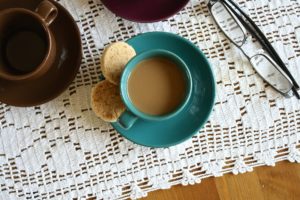- Calls to this hotline are currently being directed to Within Health, Fay or Eating Disorder Solutions
- Representatives are standing by 24/7 to help answer your questions
- All calls are confidential and HIPAA compliant
- There is no obligation or cost to call
- Eating Disorder Hope does not receive any commissions or fees dependent upon which provider you select
- Additional treatment providers are located on our directory or samhsa.gov
The Importance of Incorporating Fear and Challenge Foods in Recovery

Contributed by: Rebecca Hart, RD, LDN and Caitlin Royster, RD, LDN, Registered Dietitians at The Center for Eating Disorders at Sheppard Pratt
As registered dietitians at an eating disorder treatment program, we have the privilege of working on a daily basis with people of all ages and genders as they recover from their eating disorders. A question we frequently hear from our patients with anorexia, bulimia and binge eating disorder is: “Why does it matter if I incorporate my fear foods if I am able to meet my nutritional needs without them? Or, “Do I really need to eat [insert fear food here] to get better?”
In an effort to help support healing, here are eight reasons to incorporate fear foods or challenge foods during eating disorder recovery and to challenge the “at least I’m eating” mindset that can lead to relapse.
1. The longer you avoid something, the scarier it can become.
We find that individuals do best when they expose themselves to a fear food and work through the difficult feelings using healthy coping strategies to decrease anxiety. Once is not enough. Behavioral rehearsal – or the repetitive practicing of a behavior and appropriate response – is important.
The more you do it, the easier and less anxiety-provoking it becomes over time. The alternative – continuing to avoid a fear food – leads to more fear, increased anxiety, and reinforced negative thoughts about your perceived inability to eat that item.
2. Incorporating challenge foods helps you to determine your true taste preferences.
Everyone has true taste preferences – foods with tastes they really like and foods with tastes they really do not like. Over time, in people with eating disorders, natural preferences can become confused with eating disorder preferences.
It is important to reintroduce all foods to clearly determine one’s true motives for removing them. Individuals are then able to choose from a place of personal preference, not a weight-related fear or distortion, whether they like a particular food.
3. Adding in fear foods helps to counter “good food vs. bad food” beliefs.
At the heart of it, food is just food. Sustenance. Energy. There are no good or bad foods.
 We teach our patients how to incorporate all foods and to do so with balance and moderation. For some people, this means encouraging more fruits and vegetables. For others, this means teaching them that carbohydrates are not inherently bad and actually serve important physiological purposes.
We teach our patients how to incorporate all foods and to do so with balance and moderation. For some people, this means encouraging more fruits and vegetables. For others, this means teaching them that carbohydrates are not inherently bad and actually serve important physiological purposes.
Even people without eating disorders may struggle with assigning moral value (good/bad, clean/toxic, etc.) to specific foods which can lead to negative thoughts when eating them. For example, “I shouldn’t have eaten XYZ again; I’m so weak. I’ve been so bad. I need to cleanse” This type of thinking can lead to feeling of guilt, shame and decreased self-esteem. Having a healthy relationship with all foods is a message more of the general public can benefit from, not just those in recovery from eating disorders.
4. Eating fear foods allows you to challenge the idea of “perfect eating.”
There is no such thing as perfection when it comes to food or eating. In fact, striving to eat “perfectly” can have negative consequences. A rigid approach to food doesn’t allow for flexibility or enjoyment. Trying to adhere to a “perfect” diet can also have social consequences.
Many people with eating disorders become isolated and avoid social gatherings that involve foods that don’t fit within their predetermined “perfect” plan. Learning to eat fear foods is important in breaking out of this isolation and perfectionism trap.
5. Including feared foods helps you practice eating them in a normal and sustainable way.
If you struggle with binging and purging or other compensatory behaviors, you may think it’s best to just stop eating the foods that most often trigger those symptoms.
However, completely avoiding “trigger foods” often exacerbates cravings, promotes overeating and perpetuates the binge-purge-restrict cycle. The goal of recovery is to normalize food, not to escape it.
6. Incorporating challenge foods is a big step towards achieving a relaxed, enjoyable relationship with food.
It is perfectly okay to have a piece of cake at a birthday party – or any day at all really. It’s just fine to enjoy a glass of apple cider on a crisp fall day. Desserts, caloric beverages, and other common fear foods are all part of a normal, healthy diet.
Eating is, by design, supposed to be pleasurable. You are allowed to (and deserve to) eat foods you enjoy. Remember: this is nourishing for both your body and your mind!
7. Learning to eat fear foods can help you prevent relapse.
While you may technically be following your meal plan, without incorporating fear foods you are still giving the eating disorder a major foothold by preserving fear and anxiety. It might seem like choosing safe foods is better than acting on symptoms.
However, over time this restriction can snowball and lead back to progressively worsening eating disorder symptoms. In fact, Schebendach et al., (2008) found that diets lower in energy density and variety were associated with poor treatment outcomes in weight-restored women with anorexia (1). In other words, individuals who incorporated more variety in their meals, including higher density foods, were more likely to maintain their recovery over the long-term.
 Ultimately, treatment and recovery from an eating disorder takes time. It often involves small changes that build on each other. If you are ready to incorporate fear or challenge foods, try starting with one food at a time, one meal at a time. These small, realistic, and manageable changes are more effective and more likely to be maintained than sitting down to a meal where every single item is a fear or challenge food.
Ultimately, treatment and recovery from an eating disorder takes time. It often involves small changes that build on each other. If you are ready to incorporate fear or challenge foods, try starting with one food at a time, one meal at a time. These small, realistic, and manageable changes are more effective and more likely to be maintained than sitting down to a meal where every single item is a fear or challenge food.
You may be at a point in your recovery where eating the meal plan is all you can manage. This is reasonable at various points in the recovery process, but should not be a long-term strategy given that we know it ultimately impedes full recovery. The eventual goal is to be able to enjoy all foods in moderation without guilt or shame. This is true freedom from your eating disorder.

 About the Authors: Rebecca Hart, RD, LDN and Caitlin Royster, RD, LDN are Registered Dietitians at The Center for Eating Disorders at Sheppard Pratt. Both provide medical nutrition therapy and nutrition education to patients at the inpatient, partial hospitalization, and intensive outpatient levels of care. Rebecca also serves as The Center for Eating Disorders’ Nutrition Care Coordinator.
About the Authors: Rebecca Hart, RD, LDN and Caitlin Royster, RD, LDN are Registered Dietitians at The Center for Eating Disorders at Sheppard Pratt. Both provide medical nutrition therapy and nutrition education to patients at the inpatient, partial hospitalization, and intensive outpatient levels of care. Rebecca also serves as The Center for Eating Disorders’ Nutrition Care Coordinator.
References:
[1]: Schebendach JE, Mayer LES, Devlin MJ, Attia E, Contento IR, Wolf RL, and Walsh BT. Dietary energy density and diet variety as predictors of outcome in anorexia nervosa. Am J Clin Nutr 2008; 87:810-6.The opinions and views of our guest contributors are shared to provide a broad perspective of eating disorders. These are not necessarily the views of Eating Disorder Hope, but an effort to offer discussion of various issues by different concerned individuals.
We at Eating Disorder Hope understand that eating disorders result from a combination of environmental and genetic factors. If you or a loved one are suffering from an eating disorder, please know that there is hope for you, and seek immediate professional help.
Last Updated & Reviewed By: Jacquelyn Ekern, MS, LPC on December 19, 2016
Published on EatingDisorderHope.com

The EatingDisorderHope.com editorial team comprises experienced writers, editors, and medical reviewers specializing in eating disorders, treatment, and mental and behavioral health.

